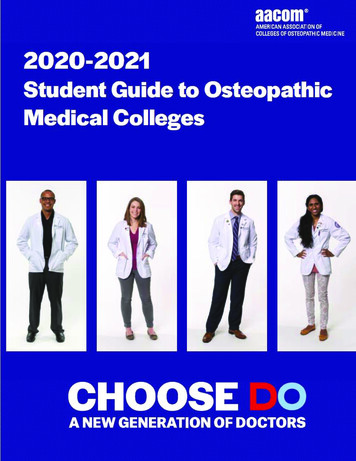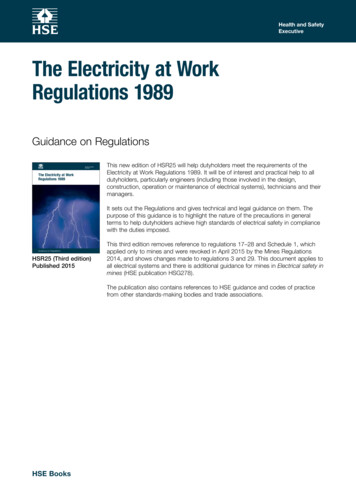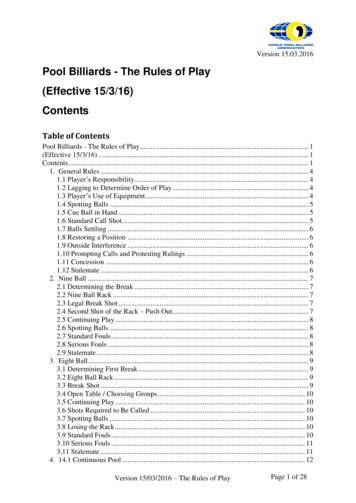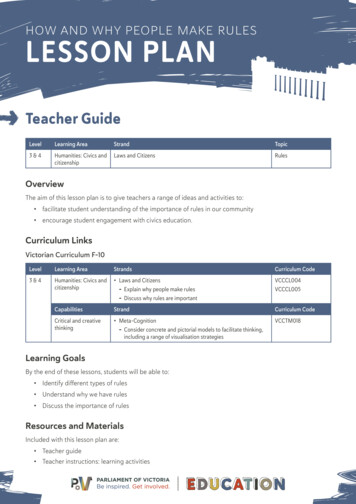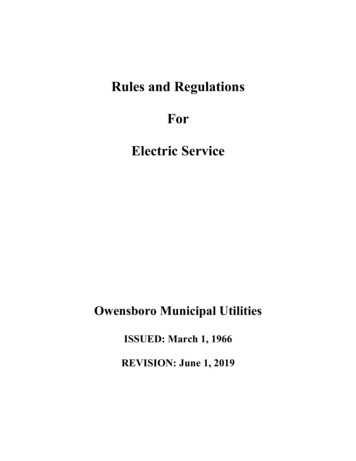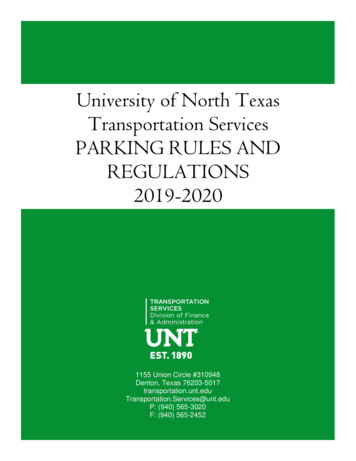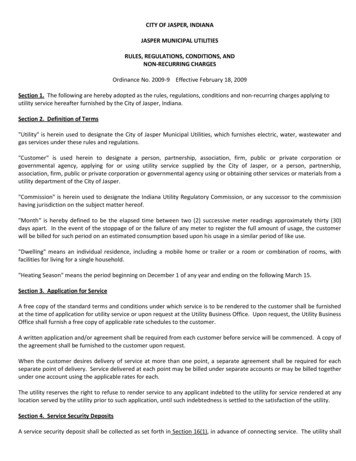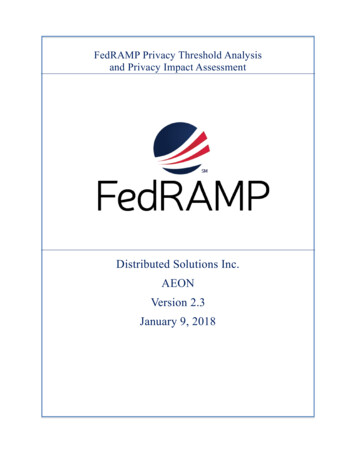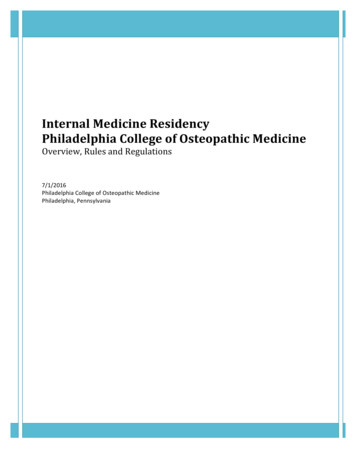
Transcription
Internal Medicine ResidencyPhiladelphia College of Osteopathic MedicineOverview, Rules and Regulations7/1/2016Philadelphia College of Osteopathic MedicinePhiladelphia, Pennsylvania
2Table of ContentsPageHospitals, Faculty. 3Residents . .12Philosophy . 14General Goals and Objectives . 15Goals and Objectives – OGME -1 . 16Goals and Objectives – OGME -2 . 18Goals and Objectives – OGME -3 . 20Goals and Objective – Office .22Rotational Goals and ObjectivesEndocrinology . 25Gastroenterology . .29Hematology/Oncology . .35Infectious Disease . 40Nephrology . .45Rheumatology . 50Cardiology . .55General Internal Medicine . .60Neurology . .69Pulmonary/Critical Care . .74Supervision Policy . .81Rules and RegulationsProgram Director . .91Resident Timetable . .93General Rules . 94Chief Residents . 98Curriculum . 101
3Section 1Faculty and Residents
4AdministrationPhiladelphia College of Osteopathic MedicineJay S. Feldstein DOPresident and Chief Executive OfficerKenneth Veit DO, FACFPProvost, Senior Vice PresidentDavid Kuo DO, FACOFPAssistant Dean for Graduate Medical EducationDaniel J. Parenti DO, FACOI, FCCPProfessor and ChairAssociate Program Director,Internal Medicine ResidencyDepartment of Internal MedicineMichael A. Venditto DO, FACOI, FCCPProfessor and ChairDivision of Pulmonary and Critical Care MedicineProgram DirectorInternal Medicine ResidencyKimberly M. JonesInternal Medicine Residency Coordinator
5Roxborough Memorial HospitalPeter J. AdamoChief Executive OfficerGregory Lenchner MD, FACIM. FCCPChairman, Department of Internal MedicinePat A. Lannutti DO, MScDirector of Medical Education (on-site)Brian Penza DO, FACOIAssociate Director of Medical EducationChestnut Hill HospitalChief Executive OfficerSimeon Bardin MD, FACIMDirector of Medical Education (on-site)
6Hospitals and FacultyRoxborough Memorial HospitalRoxborough Memorial Hospital (originally, St.Timothy's Hospital) is a 120 bed community hospital.It has been in existence for over 100 years. It services a very active and diverse area of Philadelphia.It has a busy emergency room and all the amenities contributing to a high quality of care.RMH has a full complement of sub-specialties and a recently upgraded intensive care unit and PCU.There are 3 teaching general internal medicine services which consist of medical students, interns,residents as well as a clearly indentified service director/supervisor. The patient population isprotean. There is a wide variety of disease processes from the more common to the most obscure.The hospital is in an ongoing growth mode and is committed to Osteopathic Medical Education.Roxborough Memorial Hospital FacultyAnesthesiologyLawrence Levit MDCardiologyWayne Arnold DOMichael Deangelis MD*Eva Placentra-Sesso DOErin O'Malley MDBruce Kornberg DO*Veronica Covelesky *MDDermatologyHarold Milstein MD* - indicates Board Certified
7ENT* - indicates Board CertifiedWilliam Henry MDTodd Morehouse DOStaci Levick DOLawrence Cramer DOBrian Broker MDAlan Berger MDEndocrinologyJoan Lit MDSteven Nagelberg MDNeil Streisfeld MDGastroenterologyNancy Graboyes-Leopold MDLarry Borowsky MDJennifer Lehrer MDGeneral Internal MedicinePat Lannutti DOBrian Penza DO*Cindy Henry DO*Eric Soifferman DO*Scott Peerenboom DO*Erik Polan DO*Diana Tyler Rocks DO*GeriatricsTodd Aaron MDPaula Patton MDLawrence Kessel MDKatherine Galluzzi DO*
8GynecologyJohn Misannelli DOHelene Koch DODavid Goldberg DOHematologySally Lane MDJean Kane DOInfectious DiseaseMark Ingerman MDLawrence Livornese MDBrett Gilbert DONephrologyJohn Firpo MDMichael Levin DO*Kenneth Knowles DO*Theodora Bernadini DO*Nicola Stepanian DONeurologyJoseph Lubeck DO*Ravik Sapra MDOphthalmologyAbraham Cohen MDLawrence Bloom MDAnthony Antonello MDOsteopathic Manipulative MedicineAlex Nicholas DO*Evan Nicholas DO*Donald Allison DO* - indicated Board Certified
9PathologyPradepp Bhagat MDPhysiatryManzoor Mohiuddin MDAisa Lopez MDPulmonary /Critical CareGregory Lenchner MD*John Simelaro DO*Michael Venditto DO*Daniel Parenti DO*RheumatologyMelanie Chatterji MDRichard Pascucci DO*UrologyPatrick Lenahen MD* - indicates Board Certified
10Chestnut Hill HospitalChestnut Hill Hospital is a community-based, university-affiliated, teaching hospital committed toexcellent patient centered care. The 164 bed hospital offers a range of inpatient and outpatient,diagnostic and treatment services for our neighbors in northwest Philadelphia and easternMontgomery County.More than 300 board-certified physicians comprise the medical staff and support medicalspecialties including minimally invasive laparoscopic and robotic-assisted surgery, cardiology,gynecology, oncology, orthopedics and more. their comprehensive services also include primarycare practices, two Women's Centers and an off-site physical therapy center. Accredited by TheJoint Commission, CHH is affiliated with university hospitals in Philadelphia for heart, stroke andcancer care, as are the hospitalist and residency programs.Chestnut Hill Hospital FacultyCardiologyAndrew Woldow MD*Kelly Anne Spratt DO*David Chinn MD*Thomas Diaz MD*EndocrinologyClaresa Levetan MD*Bertram Channick MD*GastroenterologyGerald Bertiger MD*James Taterks MD** - indicates Board Certified
11General Internal MedicineSimeon Bardin MD*Eric Soifferman DO*Kenneth Hoellein MD*Jarrod Eddy DO*Cindy Henry DO*Scott Peerenboom DO*Lawrence Kessel MDDiana Tyler Rocks DO*Infectious DiseaseBrett Gilbert DO*Mark Ingerman MD*Lawrence Livornese MD*Bevin Dolan MD*NephrologyEdward Jones MD*Thomas Delgiorno MD*William McElhaugh DO*NeurologyVidhu Gupta MD*Rodney Bell MD*David Cohen MD*Sonya Knight DO*Pulmonary/Critical CareScott Rosenberg MD*Aaron Crookshank MD*Richard Depuis MD*Nicole Scivoletti DO*RheumatologyRobert Kimelheim DO*Mohan Gurubhagavatula DO* - indicates Board Certified
12ResidentsOGME-1James BarrettPaul CowanKyle DavisDominic DeAngeloMarie-Claudia DurkinConor O'SullivanSarah SalamaMaria Lynn ShiptoskiOGME-2Marissa BabnewDavid HannaPaul LiRachel MaselKhoa (Richard) NgoDouglas RheamBarbara SchechterAlex SnyderAshad SyedOGME-3Mina GhobrialJoshua MenefeeAlexander MorseAdrian PearsonElizabeth ThomasAndrea VarrauxChristopher Webb
13Section 2Philosophy, Goals, and Objectives
14PhilosophyThe internal medicine residency at the Philadelphia College of Osteopathic Medicine is acomprehensive 3 year program with intensive training in all facets of internal medicine. It stressesthe importance of osteopathic philosophy both in the diagnosis and treatment of patients. Theprogram allows the residents to develop into excellent healthcare providers and prepares them totake the certification examination in internal medicine.This will be accomplished by only providing services where teaching and supervision is a premium.To provide diversification of patient experience and teaching attendings, all residents will rotate atboth Roxborough Memorial Hospital and Chestnut Hill Hospital.
15Goals and Objectives For All ResidentsAll residents are to develop the following competencies:--A solid foundation of basic science and clinical knowledge of internal medicine.--The ability to provide compassionate and effective care to all patients.--The exercise of clinical judgment to critically select the appropriate course of action in themanagement of patients.--The capacity to communicate effectively with all healthcare personnel and with patients.--The ability to analyze practice experience and perform practice-based improvement activitiesusing a systematic methodology.--Apply knowledge of study designs and statistical methodology to the appraisal of clinical studiesand information regarding diagnostic and therapeutic effectiveness.--A demonstrated commitment to carrying out professional and administrative duties, adherence toethical principles and sensitivity of diverse patient population.--The constant pursuit of improvement in patient care practices by systematic evaluation of currentpractices in relation to outcome and to new scientific knowledge.--An awareness of and responsiveness to the underpinnings of the health care system, and thedilemmas of practicing healthcare that is of optimal value, and cost effective.
16Goals and Objectives for OGME-1Patient Care--Perform a thorough history and physical examination with complete, accurate and timelydocumentation.--Understand indications for and interpret lab and imaging studies.--Learn to counsel patients appropriately for obtaining informed consent.--Perform a minimum of 5 supervised central lines in the subclavian, internal jugular and femoralpositions.--Become proficient in endotracheal intubation.--Become proficient in obtaining an arterial blood gas.--Learn to provide exemplary patient care using a team approach.Medical Knowledge--Successfully complete rotations in ICU, Emergency room, anesthesia, ambulatory women's healthissues, ambulatory medicine, and the required 6 additional rotations in internal medicine.--Pass Comlex step 3 by the end of OGME-2 year.--Establish an effective self-study reading program including textbooks and literature.--Take the in service exam as a self assessment barometer.--Develop a foundation for clinical problem solving and decision making.--Demonstrate a solid foundation of knowledge of anatomy, physiology and pharmacology.Professionalism--Demonstrate professional behavior at all times including appearance, promptness, andinteractions with patients, family, staff, and healthcare providers.--Demonstrate sensitivity and responsiveness to patients' culture, age, gender, and disabilities.--Demonstrate integrity and a commitment to patients that supercedes self interest.Communication and Interpersonal Skills--Provide compassionate patient care as determined by patients, families, colleagues, and ancillarymembers of the health care team.--Work effectively as a member of the health care team.--Show a sense of camaraderie and cooperation with fellow house staff officers.
17Systems-based Practice--Advocate for quality patient care and assist patients in dealing with healthcare systemcomplexities.--Understand the practice of medicine in both a community and a tertiary care center.--Practice cost-effective health care and resource allocation through evidence-based medicalpractice that does not compromise quality of care.--Maintain records of office patients seen and procedures performed.Practice-based Learning--Learn information technology skills to access available patient care and educational resources.--Demonstrate an ongoing ability to learn from errors.--Begin to locate, appraise, and assimilate evidence from scientific studies related to clinical medicalpractice and research.Osteopathic Knowledge and Skills--Complete a thorough and accurate osteopathic examination.--Begin to understand how alteration of structure can help in the diagnosis of the patient.--Incorporate OMM into the treatment plan of the patient.--Understand when OMM consultation is appropriate.
18Goals and Objectives for OGME-2Patient Care--Perform a thorough history and physical with complete, accurate and timely documentation--Further the understanding of the indication for and the interpretation of lab and imaging studies.--Learn to counsel patients appropriately for obtaining informed consent for all procedures.--Generate patient care plans under the direction of chief residents and faculty.--Expand knowledge base for indication and interpretation of procedures used in the subspecialtiesof internal medicine.--Expand the ability to care for the internal medicine issues in the perioperative period.Medical Knowledge--Pass Comlex 3 by the end of this year.--Establish an effective self-study reading program including textbooks and journal literature.--Demonstrate a solid foundation of knowledge of anatomy, physiology, and pharmacology relatedto the care of the patient.--Take the in service exam as a self assessment barometer.--Continue to develop problem solving skills.Professionalism--Demonstrate professional behavior at all times including appearance, promptness and interactionswith patients, family, staff, and healthcare providers.--Demonstrate sensitivity and responsiveness to patients' culture, age, gender, and disabilities.--Demonstrate integrity and a commitment to patients that supersedes self interest.Communication and Interpersonal Skills--Provide compassionate patient care as determined by patients, families, colleagues, and ancillarymembers of the health care team.--Works effectively as a member of a health care team.--Shows patience while supervising junior house staff and students.--Participate in programs involving the first and second year medical students as requested by thechief resident.Systems-based Practice
19--Understand their role in both the hospital and office setting, including interactions with otherhealth care organizations, and how these elements of healthcare affect the practice of medicine.--Advocate for quality patient care and assist patients in dealing with healthcare systemcomplexities.--Practice cost-effect health care and resource allocation through evidence-based medical practicethat does not compromise quality of care.--Continue to maintain logs on office patients seen and procedures done.Practice-based Learning--Learn information technology skills to access available patient care and educational resources.--Demonstrate an ongoing ability to learn from errors.--Continue to locate, appraise, and assimilate evidence from scientific studies related to clinicalinternal medicine.Osteopathic Knowledge and Skills--Complete a thorough and accurate osteopathic examination.--Continue to develop an understanding of how alteration of structure can help in the diagnosis ofthe patient.--Incorporate OMM into the treatment plan of the patient.--Understand when OMM consultation is appropriate.--Participate in the OMM seminars.
20Goals and Objective for OGME-3Patient Care--Perform a thorough history and physical with complete, accurate and timely documentation.--Understand the indications for and the interpretation of studies.--Counsel patients appropriately for obtaining informed consent for procedures.--Counsel patients on end of life issues.--Generate and implement patient care plans under the guidance of the attending faculty.--Provide exemplary patient care as part of the internal medicine team.Medical Knowledge--Continue an effective self-study reading program including textbooks and journals.--Demonstrate advanced knowledge of anatomy, physiology, and pharmacology related to the careof the internal medicine patient.--Demonstrate complex and appropriate problem solving and decision making in all the internalmedicine subspecialties.--Know when appropriate subspecialty consultation is needed and how to incorporate theirrecommendations into the medical plan for the patient.Communication and Interpersonal Skills--Provide compassionate patient care s determined by patients, families, colleagues, and ancillarymembers of the health care team.--Works effectively as a member of a health care team including teaching medical students,residents and ancillary healthcare providers.--Participate in programs involving the first and second year medical students as requested by thechief residents.Systems-based Practice--Understand their role in both the hospital and office setting, including interactions with otherhealth care organizations, and how these elements of healthcare affect the practice of medicine.--Advocate for quality patient care and assist patients in dealing with healthcare systemcomplexities.--Practice cost-effect health care and resource allocation through evidence-based medical practicethat does not compromise quality of care.
21--Continue to maintain logs on office patients seen and procedures done.Practice-based Learning--Demonstrate advanced information technology skills to access available patient care andeducational resources.--Demonstrate an ongoing ability to learn from errors.--Locate, appraise, and assimilate evidence from scientific studies related to an internal medicinepractice.Osteopathic Knowledge and Skills--Complete a thorough and accurate osteopathic examination.--Develop an profound understanding of how alteration of structure can help in the diagnosis of thepatient.--Incorporate OMM into the treatment plan of the patient.--Understand when OMM consultation is appropriate.--Participate in the OMM seminars and the OMM modules available on line.
22Goals and Objectives for the OfficeOGME-1--Learning to develop a rapport with the patient that the resident should continue to see in theoffice.--Be able to easily ascertain what is the chief complaint and then to be able to expand this in theHPI.--Develop a differential diagnosis and begin to establish a plan of care for the patient.--Begin to master some of the office procedures such as EKG, spirometry, pulse oximetry andbimanual pelvic exam.--Learn procedures for getting labs and radiology studies done.--Learn the indications for manipulative therapy. Learn new techniques as appropriate.--Understand the cost-effectiveness of pharmaceuticals.--Learn EMR.--Begin to understand billing codes.--Learn how to return patients' phone calls and deal with some appropriate issues over the phone.OGME-2--Continue to develop a more extensive differential diagnosis.--Be able to educate the patient on health maintenance.--Refine techniques for office procedures--EKG, spirometry, etc.--Refine the ability to use EMR and e-prescribing.--Begin to understand office management such as registration, and precertification of tests andprocedures.--Develop an understanding of the appropriate use of consultations.--Further develop the understanding of billing codes.--Learn how to use ancillary services such as hospice, social services, genetic counseling, familyplanning and addiction services.--Teach the students and OGME-1's.--Learn when care is no longer outpatient appropriate.
23OGME-3--Be able to narrow the differential diagnosis in a cost-effective way.--Teach students and junior residents.--Develop an expertise in issues of emotional and/or social stress.--Have an understanding of the functioning of an office including personnel responsibilities,equipment need and maintenance and space allocation.--Become more efficient in both seeing patients and returning phone calls to patients.--Refine manipulative skills.
24Rotational Goals and Objectives
25Goals and ObjectivesEndocrinology RotationEducational PurposeMaintaining normal endocrine function is crucial for optimal health. Both primary andsecondary endocrine processes cause disease states. During the one-month endocrinology andmetabolism rotation, the PGY2 or 3 resident will learn about normal endocrine function as well ascommon and uncommon endocrine disorders and their evaluation and management. The majorobjective of this rotation is to train residents to apply the principles of endocrinology to themanagement of common physiologic derangements.Residents will be exposed to a broad spectrum of endocrinologic disorders demonstrating theclinical relevance understanding metabolic and physiologic derangements. The socioeconomic andhealth benefits of optimal control of diabetes are emphasized.Occupational behavioral factors often affect the chronic management of manyendocrinologic conditionsDisease MixThe following topics are emphasized during the endocrinology/metabolism rotation.A. The performance and interpretation of thyroid function tests and immunoassaytechniques.B. The essentials of diabetic care including intensive insulin management of Type 1diabetes, recommended guidelines to avoid chronic complications such asnephropathy, retinopathy, and neuropathy.C. Optimal management of the patient with Type 2 diabetes.D. Evaluation and management of diabetic ketoacidosis.E. Evaluation and management of hyperosmolar nonketotic states.F. Diagnosis and management of thyrotoxicosis, hypothyroidism including myxedemacrisis, Graves disease, management of the thyroid nodule, and differentiated thyroidcancer.G. Evaluation and management of hypercalcemia including hyperparathyroidism.H. Metabolic bone disease including osteoporosis and osteomalacia.I. Pituitary disorders including prolactinoma, acromegaly, and non-secreting tumors.J. Management of Cushing syndrome, Cushings disease and ectopic steroid production.K. Multiple endocrine neoplasia syndromes.L. Multiple endocrine autoimmune failure syndromes.M. Addison’s disease and acute adrenal crisis.N. Hypopituitanrism.O. Evaluation for pheochromoctyoma, carcinoid syndrome, and mastocytosis.
26P. Evaluation of galactorrhea and gynecomastia.Q. Congenital disorders presenting as adult diseases such as Turners syndrome,Kleinfelters syndrome, congenital adrenal hyperplasia.R. Feminizing disorders.S. Diabetes insipidus.Patient CharacteristicsIn contrast to most resident rotations, the endocrinology/metabolism rotation primarilyinvolves outpatients and, generally, those in stable conditions. Residents will have theopportunity to experience management of stable diabetic patients and learn about thedisabilities exacerbated by poor control. The patients seen on the rotation will reflect awide socioeconomic base including patients from the endocrinologist’s private practice as well as inthe resident clinic and the hospital consultation service.Types of Clinical EncountersPatient evaluated on this rotation will primarily be outpatient in the office of the facultyendocrinologist as well as in the resident endocrinology clinic. Residents will besupervised at all times by on-site faculty members and will have the opportunity todiscover the importance of allied nursing personnel in the optimal management ofdiabetes. The importance of diabetic nurse educators is emphasized daily.Procedures and ServicesResidents will have the opportunity to occasionally observe thyroid biopsies as well asparticipate in various stimulation and collection procedures to identify syndromes ofexcess or insufficient hormonal production.Pathological MaterialResidents will be encouraged to review biopsies obtained during this rotation as well asthe pathological material from those patients undergoing surgical procedures to diagnose or treatendocrinologic conditions. Occupational and environmental issues concerning radiationcontamination and disposal of low level radioactive waste from the treatment of thyroid disorderswill be discussed.
27Educational Objectives1. Diabetes mellitus. Differences between Type 1 andType 2 diabetes. Natural course of diabetes and its complications.Appropriate monitoring methodologies to include home glucosemonitoring, glycated proteins and urine protein excretion. Dietarymanagement and pharmacological therapy to include intensive insulinprograms, non-insulin injectables, oral hypoglycemic medications,. Patientrecommendations for "sick days" and treatment of hypoglycemia.Management of commonly associated disorders (hyperlipidemia andhypertension) and their interaction with diabetes managementAppropriate and timely referrals to ophthalmology, podiatry,dietary and the diabetes education program.2. Thyroid disease. Diagnostic evaluation andmanagement of the functional thyroid disorders (hypothyroidism andhyperthyroidism). Treatment options for hypothyroidism and hyperthyroidism.Evaluation of anatomic thyroid abnormalities (simple goiter, multinodulargoiter and solitary thyroid nodule) to include use of nuclearmedicine procedures, ultrasound studies and fine needle aspiration.Evaluation of thyroid function tests in the intensive caresetting.3. Lipid disorders. NCEP guidelines. Secondaryhyperlipidemia, dietary and pharmalcologic management ofdyslipidemias.4. Metabolic bone diseases. Diagnostic evaluation andtreatment options of osteoporosis and osteopenia. Risk factors for osteoporosis.The use of bone densitometry. Osteomalacia, Paget's disease.5. Calcium disorders. Diagnosis and management ofhypercalcemia and hypocalcemia. Management ofhyperparathyroidism (medical vs. surgical). Management of criticalhypocalcemia and hypercalcemia. Diagnosis and management of vitaminD deficiency.6. Adrenal disease. Diagnosis and management ofCushing's syndromes, adrenal failure and pheochromocytoma.Diagnosis and management of adrenal emergencies (adrenal orpheochromocytoma crisis). Evaluations of the incidental adrenalmass.
287. Pituitary disease. Diagnostic evaluation ofpituitary tumors to include the incidental pituitary mass. The roleof surgery, radiation therapy and medical management. Diagnosis andmanagement of pituitary apoplexy. Empty sella syndrome. Diagnosisand evaluation of posterior pituitary dysfunction such as central DI and SIADH8. Gonadal Dysfunction. Diagnostic evaluation ofgynecomastia, hirsutism, amenorrhea and impotence. Androgen andestrogen replacement therapy.Method of Evaluation of Resident PerformanceResidents will be evaluated in the following manner:A. Discussion of assigned topics and required reading by the faculty member andresident.B. Assessment of resident skills in evaluating patients presenting with endocrinologiccomplaints.C. Completion of any required reading list.D. Completion of any required clinical teaching sessions.E. Attending end-of-month written evaluation
29Goals and ObjectivesGastroenterology RotationEducational PurposeGastrointestinal and hepatic disorders frequently cause patients to seek medical attention.Abdominal pain, diarrhea, weight loss and other abdominal complaints are common presentingcomplaints. Hepatitis affects occupational choices and is a particular risk to health care workers,such as physicians. Alcohol abuse and its complications affect all socioeconomic groups. An internistmust acquire sufficient skill and knowledge to evaluate and manage common as well as uncommongastrointestinal and hepatic disorders.During the gastroenterology/hepatology (GI) rotation, emphasis will include thefollowing:A. Normal and disordered hepatic and GI tract function.B. Evaluation and management of common gastrointestinal diseases, both inpatient andoutpatient.C. Exposure to patients with complications affecting the GI tract.D. Exposure to patients with multi- system diseases, affecting the GI tract.E. Exposure to common GI procedures including endoscopic, biopsy and aspirationprocedures during which time the resident will develop knowledge of indications,contraindications and complications of these procedures.F. If requested, individual opportunity to perform flexible sigmoidoscopy.Teaching MethodsThe principal teaching methods on the GI rotation include the following:A. Self-directed readings, as well as preparation for presentations.B. Evaluation of inpatients and outpatients followed by presentation and discussion withthe attending gastroenterologist.C. Exposure to and performance of gastroenterologic procedures including discussionsof their indications and complications.D. Teaching rounds with discussion of specific topics using a didactic format.E. Discussion of assigned and required readings.
30Disease Mix and Learning TopicsA. History and physical exam techniques for evaluation of gastrointestinal complaints.B. Developing expertise in selecting appropriate laboratory, radiographic andendoscopic studies for evaluation of gastrointestinal disorders and diseases.C. Developing procedural skills including paracentesis, NG intubation, and possiblyflexible sigmoidoscopy.D. Developing a knowledge base for the use/interpretation of the following tests.1. Fecal leukocytes, blood, OVA and parasites, fat (qualitative and quantitative).2. Esophageal motility studies, extended pH monitoring, Bernstein test andbarium studies.3. 3. Endoscopy with biopsy4. Helicobacter pylori testing.5. Serology of hepatitis.6. CT, abdominal MRI studies, ultrasound of abdomen, abdominal angiography.7. Stool studies for evaluation of secretory and osmotic diarrhea.8. Stool studies for evaluation of surreptitious diarrhea and laxative abuse(electrolytes, osmolality, etc.9. Tests for evaluating malabsorption andmaldigestion.10. Tests for evaluating the biliary tract, pancreas and gall bladder.11. Selected GI hormonal studies.12. Hepatic function studies.E. The following GI problems will be reviewed during the rotation1. Evaluation of dysphagia.2. Non-cardiac chest pain.3. Gastroesophageal reflux disease.4. Esophageal motility disorders.5. Acid peptic disease (H, pylori, gastric irritant use, etc.).6. Biliary tract diseases - stone disease, cholecystitis.7. Cholestatic syndromes.8. Motility disorders primary and secondary (Irritable bowel syndrome, chronicpain, constipation, etc.)9. Inflammatory bowel diseases10. Viral Hepatitis-classification, serology, management (including both acuteand chronic forms).11. Acute and chronic diarrhea.12. Upper and lower gastrointestinal bleeding (including both acute and occult).13. Evaluation and management of ascites (including spontaneous bacterialperitonitis).14. Evaluation and management of the complications of cirrhosis.15. Evaluation and management of both acute and chronic pancreatitis.16. Malabsorption and maldigestion work-up and syndromes.17. Divertricular disease, management and complications.18. Constipation.
3119. Fecal incontinen
Chestnut Hill Hospital Chestnut Hill Hospital is a community-based, university-affiliated, teaching hospital committed to excellent patient centered care. The 164 bed hospital offers a range of inpatient and outpatient, . --Perform a minimum of 5 supervised central lines in the subclavian, internal jugular and femoral positions.
